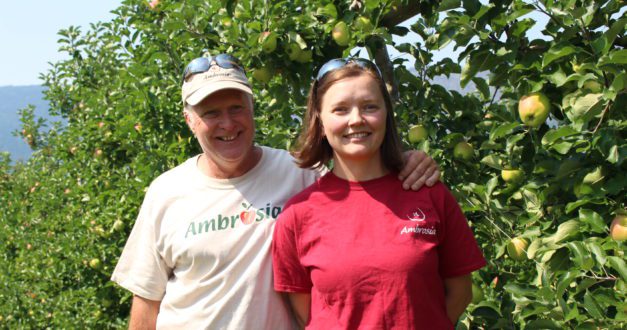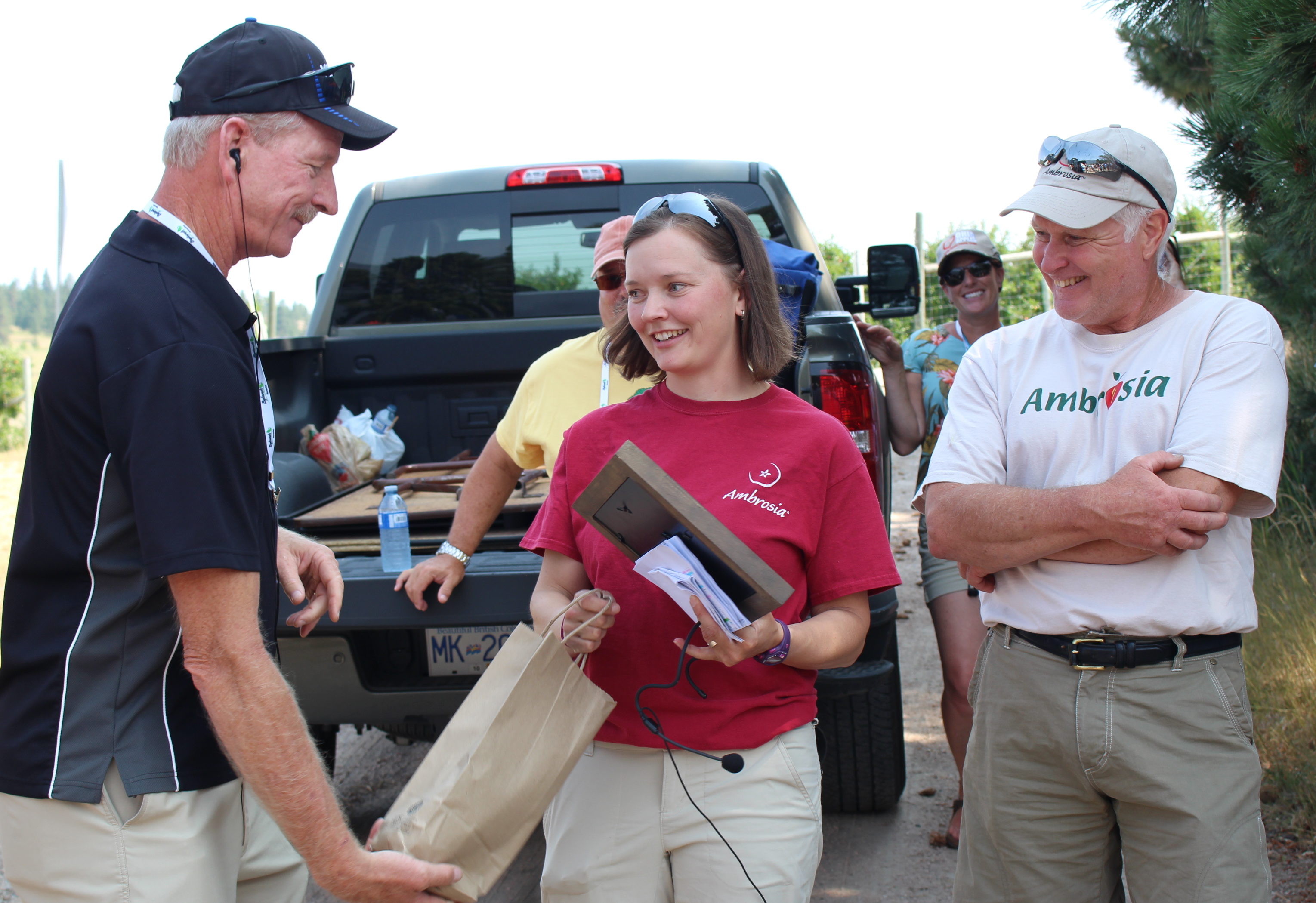

Feb 18, 2019High-density orchard innovators excel in British Columbia
Since 1949, the van Roechoudt family has been growing apples on Dorenberg Orchards near Kelowna, British Columbia, Canada. Today, the farm’s award-winning Ambrosias, Gala and Sunrise apples reflect decades of family wisdom blended with the latest agricultural techniques.
The farm, located 30 minutes north of Kelowna overlooking Okanagan Lake, was the final stop on the 2018 International Fruit Tree Association’s Summer Study Tour.
“Together, with our annual crew we hand pick our apples, selecting for ideal color, maturity and size,” said Madeline van Roechoudt, the president of Dorenberg Orchards who is the third generation of her family farming the orchard. Madeleine is the daughter of the late Marc and Tessa van Roechoudt, and granddaughter of Louis and Suzanne van Roechoudt.


Apple harvest starts in August with Sunrise, running through mid-October with the end of Ambrosia, van Roechoudt said. As the van Roechoudt family has done for three generations, the farm still ships its apples to the local cooperative packinghouse, where they’re sold under the BC Tree Fruits label.
Ever since Louis van Roechoudt pioneered the dwarf trellis system in the Okanagan, the family has embraced innovative growing methods, management systems and varieties.
“We were one of the first orchards to cultivate the new Ambrosia apple back in the 1990s and are one of the largest growers in B.C.,” Madeline van Roechoudt said.
Today, with the growth of the Okanagan as a wine region, Dorenberg Orchards has converted 10 acres to riesling and pinot Auxerrois winegrape production on its steepest slope. The first harvest was in 2010. Grapes are harvested between late October and early November and are shipped to the neighboring Gray Monk Estate Winery.
Louis van Roechoudt of Dorenberg Orchards was the first grower to adopt dwarfing rootstocks in the 1950s in British
Columbia with a 6-foot-by-11-foot-spaced Golden Delicious planting. He was the first to show dense plantings could be commercially viable in the Okanagan.
The family pioneered a trellising system where the tops of trees were trained along wires in a single plane, and the bottom of the canopy is 3D. This is believed to help poor-coloring varieties get color into the bottoms of the tree.
The family has since transitioned to a five-wire super spindle system. Branches are laid down on the wires to create fruiting walls.
“Put the supporting system in well the first time and it will be kind to you,” said Raymond Fisher, orchard manager.
The first Ambrosia planting at Dorenberg Orchards in Winfield, B.C., was planted in the early- to mid-1990s. Even then, the block generated $1,000 a bin.
“A little light bulb when off in our heads,” Fisher said.
Since then, the operation has expanded its Ambrosia production, with 20 acres currently planted. The current Ambrosia planting had rootstock under plastic. It has a density of 2.8 feet by 9.5 feet on M.26.
“It seems like a match made in heaven,” Fisher said of this rootstock and variety planting. He said Ambrosia produces short fruiting shoots (dards) and the M.26 rootstock puts the tree on a more linear track.
Getting Ambrosia to the top wire by the third leaf with a repeated renewal of fruiting wood is the goal, Fisher said.
“Limbs that grow into the wire can’t renew,” he said, noting the farm removes big limbs in search of “a nice, flat response.”
Madeline van Roechoudt said the site’s change in soils on hilly terrain adjacent to Lake Okanagan creates challenges. The soil shifts from beach sand at the bottom of the slope with clay formations near the top of the orchard.
Higher elevations get more irrigation and drip is used separately. Overhead cooling also is used to cool down the orchard.
“I’m still a guy who likes the deep water cycle,” Fischer said.


A piece of history
According to Dorenberg Orchards’ website, in 1949, the Van Roechoudt family emigrated to Canada from Belgium and purchased 24 acres of the Rainbow Ranch from James Goldie. Shortly thereafter, an adjacent 14 acres became available and was also purchased. The 1950s were marked by a series of harsh winters which severely damaged and even destroyed many of the fruit trees due to extremely low freezing temperatures.
The resulting poor income prospects obliged Louis van Roechoudt to take on additional work as a farm manager at Vernon Orchards, while Suzanne contributed to crop thinning and sorting fruit for several harvest seasons at the Vernon Fruit Union Packing house in Woodsdale.
Marc, the oldest son and father of Madeline van Roechoudt, spent his summers and evenings after high school helping to maintain the orchards and carry out seasonal tasks. Originally the land was planted mainly with peaches, apricots and apples all at a standard spacing (20 feet by 20 feet). Most of the apple varieties were old and eventually became obsolete. Louis used his knowledge of European high-density fruit growing systems to replant his orchard. Louis planted varieties more in demand and used dwarf rootstocks, which could be planted at higher densities and came into production earlier.
Marc took over from his father in 1969 when Louis retired. The orchard consisted of apples, cherries, pears and apricots. Marc grew many different crops but eventually specialized in apples.
A good relationship with the Pacific Agriculture Research Centre in Summerland, British Columbia, was developed. Dorenberg Orchards often conducted trials of new varieties as they were tested for commercialization. Marc was always interested in new varieties and this relationship allowed him to be a very early adopter of new varieties.
– Gary Pullano, FGN Managing Editor














